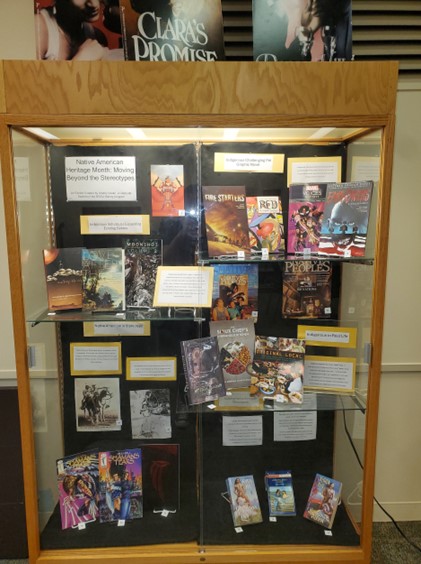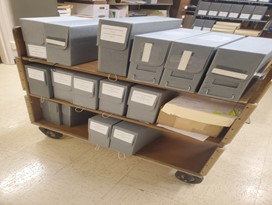Join us as we hear from last year’s public history interns! Graduate students in history at BGSU completed internships across the state in 2024. Today, we’ll read about Shelby Vasko’s experience working for the Browne Popular Culture Library at BGSU.

The following reflection was written by Shelby Vasko and has been lightly edited.
I went into this internship with a lot of preconceived notions. I knew very little about archiving and processing, except for what I had read in my public history courses. I assumed I would just organize papers and manuscripts all day. The amount of decision-making that went into processing collections and how different the condition of each collection could appear never even crossed my mind. Despite my lack of knowledge, I went into this internship with the hope of learning more and gaining practical experience.
The Browne Popular Culture Library (Pop Culture Library) became my first choice because of its location, but also because of the content of the collections it offers. Despite my main historical interests fluctuating over the years, culture has remained at the forefront of how I view history and what I like to learn about best. Folklore has become my most recent interest. Both exploring its place in communities and the impact it has had on people and historically. When I looked at the collections and materials kept by the Pop Culture Library I found my interest piqued. They had information on all manner of popular culture, but they also had a variety of books and other printed materials on folklore. They covered topics such as folkloric foods, ghost stories, regional legends, myths, and many others.
I chose my collections with my interest in folklore in mind, but also because I hoped to turn one of them into a possible Public History project for my Capstone. I planned throughout the summer ways that I could turn different collections into projects, but it was difficult to get far without actually seeing them in person or having actually started the process. I landed on the Leonard R.N. Ashley Collection and the Gina Cerminara Papers. The Ashley Collection was my top choice because of his profession as a linguist and folklorist. Ashley wrote such books like, The Complete Book of Vampires, The Complete Book of Werewolves, and The Complete Book of Spells, Curses, and Magical Recipes. These were all dictionaries about the occult, so they mixed his interests in linguistics and folklore. I minored in Anthropology as an undergraduate and linguistic anthropology was the only discipline that I never got to take a class on of the four disciplines.
The Ashley Collection had a lot of potential to turn into a great Public History Capstone. I started processing the collection during my first week. The collection had already been partially processed, so I began by taking inventory of the already created folders and the materials in them. The process took time but was not difficult. The problem came when no folklore material appeared in the collection. The materials Ashley had donated ranged from logical to mind-boggling. He had proofs of his manuscripts and journals, but he also included cardboard drawings that had no explanation and a Military Discharge paper in French from 1808. Most of the materials had to do with linguistics and Early modern Europe.
Ashley’s Collection would not work for a Public History Capstone, so I turned my sights to the Cerminara Papers. Her collection consisted of manuscript drafts for her books. Cerminara was a parapsychologist and researched spirituality along with the supernatural. Her books had some interesting concepts and the idea of a project on parapsychology started forming, but in the end, I could not find a central theme that interested me to focus on for a topic.
Both the Ashley and Cerminara collections taught me a lot about processing. One was partially processed and the other fully unprocessed. I took detailed notes about the condition and contents of the documents and objects in the collections. Once everything had been inventoried I consulted with Tyne and Sasha Kim, the Head Librarian, to create folder titles and proper organization for the boxes. The materials were divided into series and then I could rehouse them in new folders and boxes. Processing these collections became a tedious task with learning how to properly label and score the folders to fit the manuscripts. I felt a great sense of accomplishment once I could input all the information on the collections into an Excel spreadsheet, so it could be uploaded into ArchiveSpace. The collections now had a sense of completeness to them. I worked diligently to fill out templates for finding aid information. That involved researching the background of the donors, describing the collection, and composing biographies and the abstracts. The collection process involved so many different components from start to finish but that made it more engaging and helped to showcase the nuance of processing. Processing is not just organizing but involves interpreting and decision-making skills in order to create a readable and cohesive collection that researchers can use.

While most of the internship focussed on processing, I spent a fair amount of time working on a display for the Pop Culture Library. One of the display’s needed to come down and when I expressed interest they gave me the task of coming up with an idea, researching, finding materials, and putting it together. I settled on an idea for Native American Heritage Month. From there it became a struggle of what topic to focus on. Native American representation in the media has never been the most favorable, so I thought a discussion on stereotypes would make for an interesting exhibit. The Pop Culture Library had received a new batch of books and graphic novels written and created by indigenous people, so I shifted my focus to “moving beyond the stereotypes”. Dana helped me find a lot of the materials for the display and showed me how to look for more by using specific keywords. Once I had my idea and some books I began to dive into research. I narrowed down which would work best in the display case and which didn’t fit the best with my goal. With a severely sized-down cluster of materials I began to organize and plan out the display case. This took a few days, but once everything was situated I could work on making abstracts and title cards for each section. Making the abstracts and title cards helped to put into practice a lot of what I learned in my Public History courses on exhibit planning. I had to make them readable and easy to understand. I also had to make sure that they imparted a large amount of information in as little words as possible, since most people don’t take the time to stop and read everything in a display case. Once I had finished the exhibit, it felt nice to have a physical manifestation of something that I had worked so hard on.
I learned a multitude of valuable skills and made wonderful connections, but there were times that made me question if I enjoyed the internship. A lot of the time processing the collections meant that I sat for the entire time of my shift and went through documents and books trying to record information on spreadsheets. I spent a lot of time staring at an Excel spreadsheet, both for processing but also for the migration project which involved inputting data from a complete collection so it could then be uploaded through a new database, ArchiveSpace. Because of all this most of my work time often was spent alone. Processing does require communication and teamwork skills because of the decision-making, but most of the time you work by yourself to inventory and organize the collections. The display offered a welcome reprieve, but even that required solo research. Despite the alone time, everyone at the Pop Culture Library made sure to check on me. They would offer help when I needed it and sometimes I would do my work in the reading room when it lacked students. Tyne and Sasha would offer advice whenever I sought them out, which helped make processing much easier.
This internship provided me with a lot of practical experience in both processing and working with collections of manuscripts and materials kept in libraries or archives. I learned how to discern the meaning behind disorganized collections and make them more accessible to researchers who may need to use them one day. This internship taught me that even on seemingly simple tasks, collaboration, and discussion remain very important and key in completing the final product of a collection. Through this internship, I finally could put some of the skills I had read about in my Public History classes to use. I don’t know if a job as an archivist is in my future, but it was fun to explore the basic skills necessary in the profession and to meet so many people who can offer advice if I do decide to choose this path.
